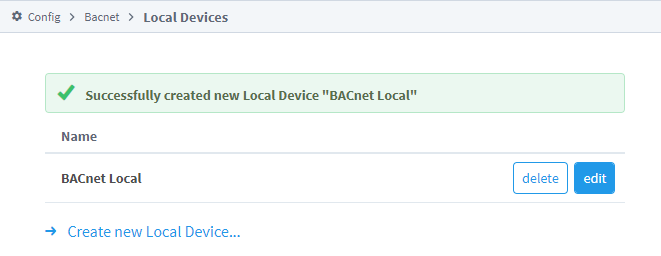BACnet Local Device
Before you can start communicating with a remote device you must first configure a local device, representing Ignition’s presence as a BACnet device on a network.
Local Devices are configured by specifying a local bind address, port, broadcast address, BACnet network, and BACnet device number. A Local Device can communicate with many remote devices as long as they are reachable on the same IP network.
Device Configuration Strategies
One strategy for configuring local devices is to configure one per network adapter that will be used for communication between the Ignition Gateway and remote BACnet devices.
The local device bind address is configured by default to a wildcard address of 0.0.0.0. This wildcard address is required to receive broadcast packets from any of the remote devices you intend to communicate with. We’ve found that some devices will only respond to the BACnet Who-Is request with an I-Am that is sent to a broadcast address regardless of whether the original Who-Is was sent unicast or broadcast.
Another situation where you may need multiple local devices is when registration as foreign device with a BACnet Broadcast Management Device (BBMD) is necessary to bridge traffic between networks. Each Local device instance can only be registered with one BBMD.
Configure a Local BACnet Device
Go to the Config section of the Gateway Webpage.
Scroll down and select BACnet > Local Devices.
On the Devices page, click on Create new Device.
Select BACnet/IP, and click Next.
Fill in the following fields:
- Name: BACnet Local
- Bind Address: Enter the IP address or leave the wildcard 0.0.0.0 default address.
- Bind Port: Enter local port or leave default of 47,808.
- Broadcast Address: Enter the IP address, for example 10.10.###.##
Leave the default values in the remaining fields.
Click Create New Local Device. You'll see the message "Successfully created new Local Device "BACnet Local."

Now you can configure a driver for the remote device.
Device Settings
General
| Local Device Setting | Description |
|---|---|
| Name | Device name. |
| Bind Address | Changed in 8.1.31 The local IP address to bind to. The default wildcard binding address is 0.0.0.0, which will process broadcast traffic for the given bind port over all interfaces. |
| Bind Port | This is the port the Device you are setting up will listen on. The local port to bind to. Default is 47,808. |
| Broadcast Address | A network address shared by other BACnet devices to send and receive UDP data. |
| Network Prefix Length | Default is 24. |
| Device Number | Default is 1,000. |
| Network Number | Default is 1. |
| Foreign Device Registration Enabled | If true, register as a foreign device with the configured BBMD (BACnet Broadcast Management Device). Default is false. |
| BBMD Address | Address of the BACnet Broadcast Management Device (BBMD) to register with. If you're planning on having this Local Device configuration work in conjunctions with a Remote Device via BBMD, then the address here should be the address of the BBMD on the same subnet as the Remote Device. |
| BBMD Port | Port the BACnet Broadcast Management Device to register with is listening on. Default is 47,808. |
Advanced
| Ignition Redundancy Setting | Description |
|---|---|
| Backup Device Number | New in 8.1.29 Device number used by the local device on the Ignition redundant backup. Should differ from the device number used on the Ignition redundant primary. Default is 1,001. |